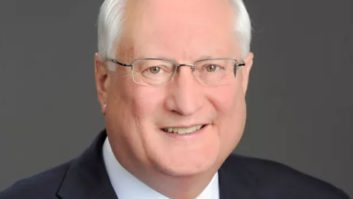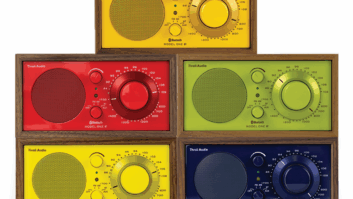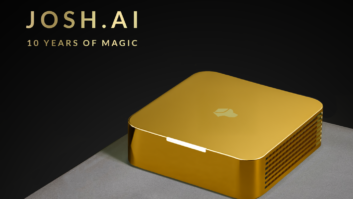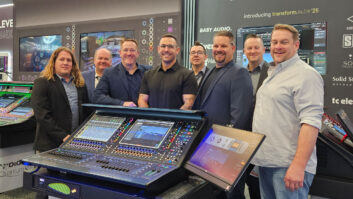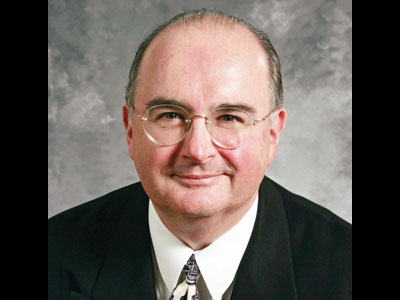
Bamonte’s, an utterly classic, 100-plus-yearold Italian joint in Williamsburg, Brooklyn, has a lot of legends on the wall. Spend some time scanning a century’s worth of old framed photos hanging in the bar in front and you’ll run across Joe DiMaggio, Yogi Berra, Knute Rockne, Joe Torre, Tommy Lasorda, James Gandolfini, Telly Savales, Jake LaMotta, and scores of old Brooklyn Dodgers and more recent New York Mets. Perhaps the latest legend to join them will be Steve Smith, who lives a few blocks away and frequents the place to the point where, like Cheers, everybody knows his name.
I sat down with Steve after his induction into the Consumer Technology Hall of Fame was announced, at a corner table, accompanied by some terrific clams and seafood entrees, to find out how a kid who grew up in this old working-class Italian neighborhood ended up at the top of the technology journalism world. The conversation was as good as the lunch.
— John Laposky
How did you get into journalism?
My mother said to me: “Try and pick out something that you like to do.” You know the whole expression about if you love your work, it doesn’t feel like work? At Bishop Loughlin High School they offered some classes on essay writing for extra credit and for training for college classes. So I started writing about social studies, current events. This was probably 1969 or 1970.
There was a lot going on then.
Yes, it was a very interesting time culturally, and I was getting really good grades for the work. So the teacher, I believe his name was Pat Quigley — he was also a basketball coach — he went out of his way to give me encouragement. And that led me to journalism. I eventually got to City College of New York which had, and still has, a very strong B.A. journalism program, with, by the way, free tuition. Yes, free tuition is still possible folks!
What was your first real journalism job?
I became the entertainment reporter of City College’s paper, The Campus. One of the first things I got to cover was a live National Lampoon performance. This was probably a year before “Saturday Night Live” debuted on TV. So I went and it was Bill Murray, John Belushi, Dan Akroyd, Lorraine Newman, Gilda Radner … and I came up with a line in my review that was something like “even if you have to steal money out of your mother’s pocketbook, go see this show!” The show ended up using that line in its subsequent ads.
After graduation, and a long period of nothing because there was a recession, I got a job with Chemical Marketing Reporter downtown where I covered oils, fats and waxes. I learned everything I could about olive oil, tallow. And I was there about a year and a half. But it was there I got my first bonus in the publishing world because I met my wife Marion there. She was in circulation, and, well, she circulated, and we met and hit it off (she’s not going to like that).
A few years later I joined my first retail publication, Toy & Hobby World. In mid-December of 1981 I was told by my editor, “You’re going to the Winter Consumer Electronics Show next month.” And I said, “What’s the Consumer Electronics Show?” So I went with an associate publisher and covered products like children’s video cassettes and video games. That’s right when Atari and Intellivision systems were becoming popular.
What is most memorable about your first CES?
Well, I had been to trade shows before and I knew what “dailies” were, but the daily at this show was massive (like it still is today). And I grabbed one and paged through it and said to myself, “Thank God I don’t have to produce a daily at this show!”
It never fails for me. As soon as I say out loud, “Thanks God I’ll never have to do that,” eventually I have to do that.
Give me your top three brushes with celebrity that came about because of your career.
Hmmm. Top three? Well, I’ll give you an industry-related one first and that was Akio Morita, one of the founders of Sony. He was, at the time, one of the real faces of the industry. He spoke English very well, and he had a very good sense of humor.
There was back then something called the International Tape Association, and he had been named Man Of The Year with a few others. It was a big deal so Sony hosted a cocktail party. Sony was divided into distinct divisions — tape, TV, audio, etc., and each of those divisions had its own president. Well, each president was present and they all had on dark suits; they looked like a team of head waiters, and we knew they had been told to be nice to the editors, get us drinks and the like.
There were maybe 10 editors there but most of them were already industry legends, all eventual Hall of Famers, like Art Levis, Bob Gerson and David Lachenbruch, among others.
So Morita is on stage at this dais addressing the editors, cracking a few jokes, and then he stopped himself and said, “Wait, why am I up here talking down to you? I’ll come to you.” So he came into the center of the room, and we circled around him and peppered him with questions for about 45 minutes. He answered every question and couldn’t have been nicer about it.
I also had the pleasure of meeting two U.S. presidents, [Gerald] Ford and [Bill] Clinton.
Ford, I really didn’t want to meet because of whole [Richard] Nixon debacle. But I heard him speak at a NATM meeting, and he spoke for an hour and half, completely off the cuff, and then he stuck around to answer questions.
Ford had a reputation as not being all that smart, but I’ll tell you he was brilliant.
President Clinton couldn’t have been nicer. Our old friend [and fellow Hall of Famer] Tom Campbell set the whole thing up after a Samsung appearance at CES.
We shook hands and I asked Tom to take a picture for me with his phone that we could run in the CES Daily. Well, Tom screwed it up, dropped his phone, and just as I was about to yell at him, Clinton said, “Tom! Don’t you know how to take a picture?” I was sure that we weren’t going to get a picture. The president says, “Give someone else the camera and let’s try it again.” So we got the picture thanks to the president.
I got to meet a lot of baseball players over the years and entertainers but one who stands out is Chuck Berry. Met him, got an autograph. It was pretty neat.
I was also at an event with the late great Arnold Palmer and he gave a terrific talk on how the game is different now and how difficult it is for young players to get into the game. I didn’t know I’d have a chance to meet him, but not only did I meet him, but I found myself one on one with him, and we had a very nice exchange. He was very nice, and after three or four minutes I felt like he was my good buddy.
So now he brings up golf and I say to him, “I sometimes play golf but most of the time I play ‘Where’s my ball?’ ’’ He’s silent for a few seconds and then he slowly turns his neck to look at me, grins, and says, “Can I use that?” I said “Mr. Palmer you can use that anytime you’d like!” We shook hands, I got a picture. He was just such a regular guy.
How about three industry people — executives, journalists, colleagues — who most influenced your career?
I’m going to limit myself to just journalists here because there are far too many people from all over the industry who taught me the ropes. But in particular there were a few fellow reporters who shared their talents, their industry knowledge with me, and made it possible for me to be successful at my job.
The first one that comes mind was Harry Van. He was the editor of Chemical Marketing Reporter. Tall, lanky guy with big arms. I found out later he had been a Class AA pitcher in the St. Louis Cardinals organization. That’s as far as he got, but he had a chemical engineering degree and was a good writer. His hiring me got my foot in the door. He had a great style of managing people. He was very low-key. And if Harry hadn’t hired me, I wouldn’t have met Marion, so I guess I have to put him on the list.
Next was Ted Erickson. He was like the dean of the toy industry in the ’60s, ’70s and ’80s. He also did PR for the industry trade organization. He was the one who hired me for Toy & Hobby World. I had gotten married, and very soon after I got laid off Ted gave me a chance. It was the first time I ever covered retail. Before that I had worked for industrial publications.
Ted taught me organization. He taught me how to treat people. Just a really good editor. He knew what he was doing. He led by example.
Next was Manning Greenberg. What can I say about him that hasn’t already been said. A classic music aficionado … big, hulking guy … but he was a sweetheart when you got to know him. I won him over because I went to a press conference with him early on and I didn’t raise my hand or ask any questions because I wanted to ask them of the executives afterward so I could get my own spin on the story. He looked at me and sai,d “Very good! That’s exactly what I do. I always save my best questions for afterward and keep the good stuff for myself. I like you!”
He was very generous with me, sharing his expertise.
Finally I have to mention Jeff Malester, who hired me at HFD and then joined us years later at TWICE. Not the flashiest guy you’ll ever want to know, but technically, for editing and everyday journalism skills, probably the best I ever worked with. And he was the classic embodiment, along with Ted Erickson, of “You set your example by how you work and go about your business … and how hard you work.” We got along just fine.
That was four, not three, but all of them deserve to be mentioned.
Are there any particular stories or events during your career that you covered, or that you had to approach as a reporter, that are particularly memorable?
The first big one, in fact, involved Manning Greenberg and Jeff Malester. Jeff, as you know, got in very early. Manning, not so much. Well we heard that morning that GE had bought RCA, and they were going to have a press conference with Jack Welch. So Jeff, Manning and I were all in the office by 8 a.m. It’s just the three of us, no one else is in yet, we’re closing the issue in two days, and this is the pre-Internet days. So we sit down and figure out what we’re going to do. Malester tells me and Manning to go the press conference and he’ll stay back and take what he could get off the wire and work the phones.
The VCR was king at the time and we asked Welch what we thought was the nut: “Will VCRs now be built in the U.S. again?” Remember, the VCR was invented in the U.S., but by that time they were all coming from Japan. And Welch looked out and said simply, “That ship has passed.”
The other one that comes to mind is the slow, gradual and then sudden death of Circuit City. It was in trouble for a while but when they pulled the plug it was a real shock to the industry. But in the end, Circuit City did more for independent retailers, and a lot of supporting companies that served independent dealers, than almost anything else because they got rid of their well-trained commissioned salespeople and a lot them went on to get hired by independents. And they followed that up by getting out of the major appliances business and some of that volume went to the independents too.
Who are your favorite writers?
Pete Hamill, who recently moved back to Brooklyn. I loved him as a columnist. He is a great novelist. Also Red Smith. I own two of his books but I remember him in his later years when he wrote for The New York Times.
Jimmy Cannon was a brilliant sportswriter. He was influenced by Hemingway, whose writing was influenced by reporting. I always liked Hemingway because his prose was sparse but told the story completely. The other one that came to mind is Gore Vidal. I loved his historical novels of the ’70s and ’80s, not necessarily his politics.
You are now officially a “legendary journalist.” What’s the state of journalism today?
We are in a precarious situation. There is simply too much major corporate ownership in the industry — and practically every other industry. Whether you consider yourself on the left, the right or in the center based on this year’s elections, very few people have any faith in the accuracy, or the integrity, of corporate-owned media. To have a vibrant democracy, you need a strong press, and I said press, not media.
The other thing is copy editing. The first people who get laid off these days are the ones who do the grunt work of real editing. It’s in a terrible state.




